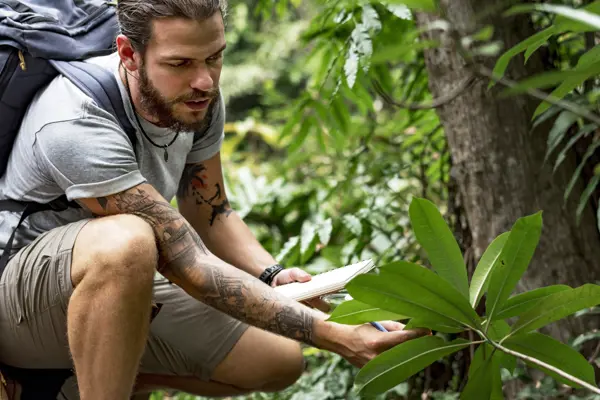
Jim Willis Studentships
2024/2025
Royal Botanic Gardens Victoria invites applications for vacation studentships honouring the late Dr James Hamlyn Willis, distinguished former senior member of staff at the National Herbarium of Victoria. You will be in the third or fourth year of a Science degree, with interests in plant and/or fungal systematics. The studentship will allow you to participate, under supervision, in one of the research programs at the Royal Botanic Gardens Victoria.
There are three studentships available and each is awarded for an eight-week period during December to February, and remuneration is $2,258.54 gross per fortnight. Applications will be assessed on the merit of the applicant.
The following three projects are offered for 2024/2025:
Contribution to the description of the fungal diversity in Australia
Fungi are among the most diverse group of organisms on Earth and play vital roles in ecosystems as decomposers and symbionts with other organisms. Despite their importance, Fungi are among the most understudied organisms, with >90% of species yet to be described. This project will focus on the formal description and publication of a new species of Fungi in the family Pezizaceae. In Australia, these cup-forming fungi are typically found on sandy soil in woodlands and sclerophyllous forests following disturbances. They frequently occur in post-fire habitats and contribute to forest recovery after wildfires.
During the project, the student will undertake the various steps of describing a new species of Fungi and gain skills in fungal nomenclature, taxonomy, microscopy, DNA sequencing, phylogenetic analysis, and scientific writing. The project will involve work in the fungarium and in the molecular laboratory.
Supervisors: Camille Truong (9252 2442, camille.truong@rbg.vic.gov.au) & Luke Vaughan (luke.vaughan@rbg.vic.gov.au)
Testing the taxonomic validity of the critically endangered Coloured Spider-orchid and a potential new related species
Spider orchids (Caladenia) are one of Australia’s most charismatic but taxonomically challenging plant genera. Further, Caladenia contains more threatened species than any other Australian plant genus, making taxonomic decisions particularly important from a conservation perspective. The Coloured Spider -orchid, Caladenia colorata, is an attractive, spring-flowering species originally described from Hartley in South Australia. The species is now recognised from South Australia and Victoria but due to habitat clearing is listed as Endangered. However, there are many similarities between of Caladenia arenaria in N.S.W and C. colorata near the Little Desert. Further, samples of C. colorata from the Little Desert have been determined as C. arenaria in the Canberra herbarium, though C. arenaria is not recognised from Victoria. This raises the possibility that C. colorata and C. arenaria could be the same taxon.
In addition to the taxonomic uncertainties regarding C. colorata, an undescribed related taxon known as C. sp. aff. colorata is considered Critically Endangered and known from one extant population in southwest of Victoria where it is at risk from multiple threats. However, no formal comparison has been undertaken with the type specimens or extant populations of C. colorata or C. arenaria. Taxonomic evaluation of this putative taxon is urgently needed to inform conservation actions.
This project will involve a review of herbarium specimens and measurement of pickled and pressed collections of C. colorata, C. sp. aff. colorata and C. arenaria from wild and shade house specimens. An analysis of morphological traits will be conducted to evaluate the taxonomic validity and taxonomic assignment of the Victorian populations of C. colorata.
Supervisors: Noushka Reiter (5990 2252, noushka.reiter@rbg.vic.gov.au) & Ryan Phillips (La Trobe University)
New Australian Fungi: describing novel taxa in an endemic Australian fungal family using DNA-, herbarium-, and imaging-based tools
The Australian endemic family Mesophelliaceae (Hysterangiales, Agaricomycetes, Basidiomycota, Fungi) has been shown to harbour a substantial level of undescribed diversity (Fungal Systematics and Evolution 8: 65–80; doi: 10.3114/fuse.2021.08.06). Species of Mesophelliaceae are ecologically important in the Australian bush as ectomycorrhizal symbionts with Eucalyptus spp. and food sources for mycophagous mammals, both of which contribute to ecological resilience after bushfires. This project will entail formally describing new taxa (genera and species) within the Mesophelliaceae. Building on previous work by the supervisor and collaborators, the student will produce phylogenetic figures and formal descriptions based on a combination of existing data and morphological data generated by the student via microscopy. The project may also involve using machine learning software to expedite the analysis of micromorphology, depending on available time.
Supervisor: Naveed Davoodian (9252 2328, naveed.davoodian@rbg.vic.gov.au)
Apply now
For general enquiries on studentships contact Frank Udovicic (9252 2313, frank.udovicic@rbg.vic.gov.au).
Applications should include a curriculum vitae (including university transcript), two referees, and a brief cover letter explaining how the applicant would benefit from the Jim Willis Studentship and how they can contribute to research at Royal Botanic Gardens Victoria, and reasons for their preference of a particular project.
Applications (single PDF only) should be emailed to Dr Frank Udovicic, Manager Research, Royal Botanic Gardens Victoria, frank.udovicic@rbg.vic.gov.au, by 11 October 2024.
